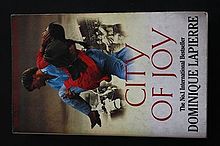- City of Joy
-
City of Joy Author(s) Dominique Lapierre Original title La cité de la joie Translator Kathryn Spink Country France Language French Publisher Arrow Publication date 1985 Published in
English1985 Pages 544 ISBN 0099140918 City of Joy is a novel written by Dominique Lapierre (1985) and a 1992 film directed by Roland Joffé.
Contents
Plot
The story revolves around the trials and tribulations of a young Polish priest, Stephan Kovalski, the hardships endured by a rickshaw puller, Hasari Pal (the sufferer) in Calcutta (Kolkata), India and the experiences of a young, American doctor, Max Lowe.
Father Stephan joins a religious order whose vows put them in the most hellish places on earth. He chooses not only to serve the poorest of the poor in Calcutta but also to live with them, starve with them, and if God wills it, die with them. In the journey of Kovalski's acceptance as the Big Brother for the slum dwellers, he encounters moments of everyday miracles in the midst of apalling poverty and ignorance. The slum dwellers are ignored and exploited by society and authorities of power are not without their own prejudices. This becomes evident by their attitude towards the lepers and the continuation of the caste system.
The story also explores how a peasant farmer Hasari Pal arrives in Calcutta with his family after a drought wipes out the farming village where his family has lived for generations.
The third main character is that of a rich American doctor who has just finished med school and wants to do something with purpose before opening up his practice catering to the wealthy.
The book chronicles not only the separation of the wealthy from the poor but the separation of the different levels of poverty, caste divisions, and the differences of the many religions living side by side in the slums. It touches on Mother Teresa and her Sisters of Mercy as well. While the book has its ups and downs, both beautiful and horrific, an overall feeling of peace and well being is achieved by the story's end. Despite facing hunger, deplorable living conditions, illness, bone breaking work (or no work at all) and death, the people still hold on to the belief that life is precious and worth living, so much so that they named their slum "Anand Nagar", which translated into English means "The City of Joy".
The author has stated that the stories of the characters in the book are true and he uses many of the real names in his book. However, the book is considered fictional since many conversations and actions are assumed or created.
The author and his wife traveled to India many times, sometimes staying with friends in "The city of Joy". Half of the royalties from the sale of the book goes towards the City of Joy Foundation[1] that looks after slum children in Calcutta.
The book was made into a 1992 film starring Patrick Swayze as the American doctor.
Awards
The book received Christopher Award[2] in 1986, given for creative work that exhibits the highest values of the human spirit.
Inspiration from Real Life
The book is set in the slum of Anand Nagar which is based on Pilkhana, Kolkata. Stephen Kovalski's character is inspired by the efforts of Gaston Grandjean[3], a Swiss nurse who moved to India in 1972 and has devoted his life in improving the welfare of slum dwellers. The book also refers to Mother Teresa and the Missionaries of Charity.
Film Adaptation
The 1992 film adaption was directed by Roland Joffé starring Patrick Swayze.
References
- ^ "City of Joy Foundation"
- ^ Christopher Award, "Dominique Lapierre"
- ^ Gaston Grandjean, Gaston Grandjean: Hero of The City of Joy
Categories:- 1985 novels
- French novels
- Kolkata
- Novels set in India
- Novels adapted into films
- 1980s novel stubs
Wikimedia Foundation. 2010.

